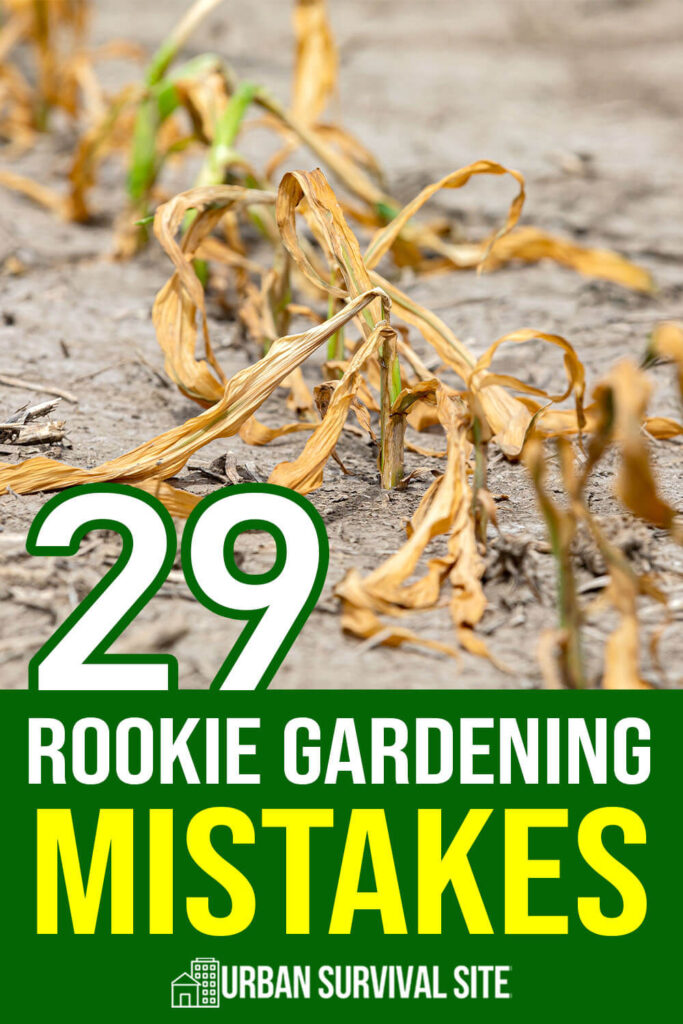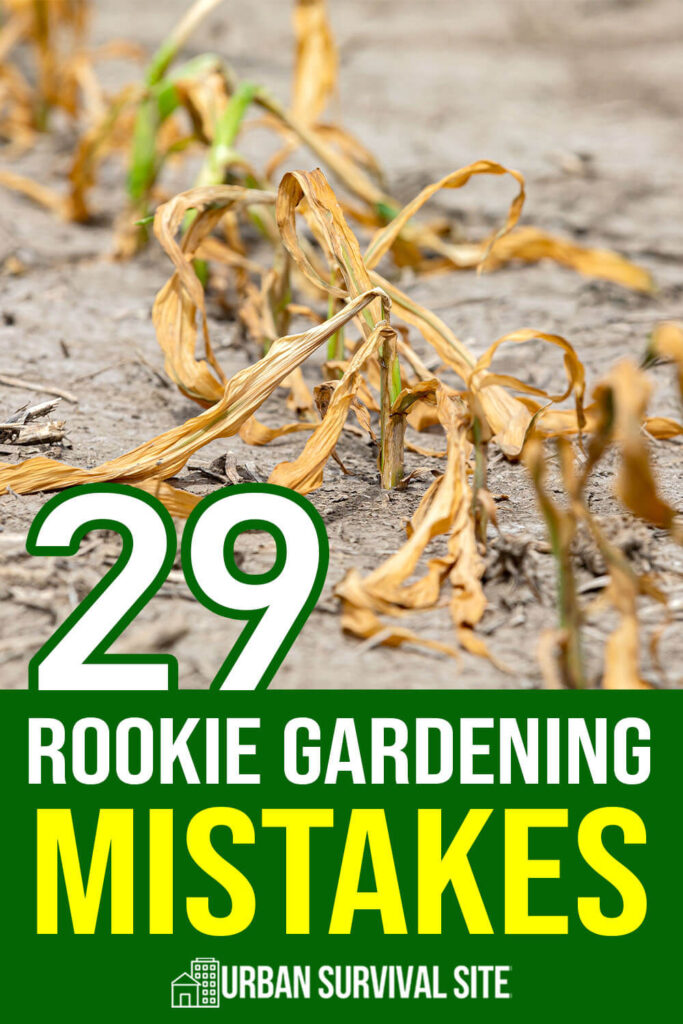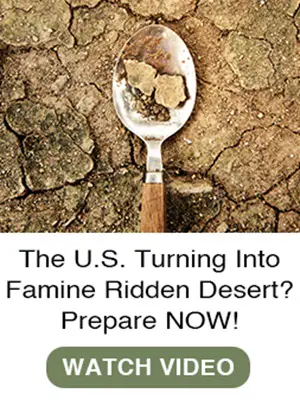

Estimated reading time: 13 minutes
For about 12,000 years humans have been growing food. Agriculture became the distinction between the stone age (or paleolithic) and the neolithic period. Wrap your head around that. We have been screwing up in the garden for 12,000 years! So, don’t feel bad.
Article continues below.
I have cobbled together most of the gardening mistakes that I have made over the years. I was surprised that in all my gardening years I was only able to come up with 29 vivid gardening mistakes that have plagued me.
Want to save this post for later? Click Here to Pin It On Pinterest!
1. Poor Garden Planning
Your garden needs 6-8 hours of sunlight and it should not be in a place that floods or so far from the house that you hate going there. Before deciding where your next garden will go you should spend a couple days watching the sun and how it hits your property.
The area that gets the most sun and is in a safe and convenient location is going to be the very best location to grow.
There are other planning considerations, too. You need to decide which plants go where in the garden. Taller plants can shade out shorter ones. Some plants go better together and thrive on what is called companion planting.
2. Allowing Trees to Overgrow
After a few years your growing area might not get as much sun if the surrounding trees begin to impact how much direct sunlight your garden gets. Trees are tricky because they grow taller and the branches grow outward. Both can wind up affecting your daily sunlight. If you are not vigilant you might not even realize it is happening.
Keep up with tree trimming or get a professional out to take care of it so your garden can get all of the sun it needs.
3. Not Covering Your Beds Over Winter
One of the most valuable parts of your soil is the microbiology. It helps breakdown nutrients that your plants need to grow big and produce lots of food. If you subject your soil to a full winter’s worth of direct sunlight the microbiology is going to suffer.
Just like the SODIS water purification method, direct sunlight kills all kinds of microorganisms. You will also subject your soil to things like erosion. Covered with a simple tarp the soil in your growing areas will be in much better shape come growing time.
4. Not Making Your Own Compost
I like to top my growing beds off with compost at the end of each growing year. Instead of buying it in bags or truckloads it’s better to just make your own from leaves, grass clippings, and food scraps that we all have access to.
You should definitely try and make your own compost. It’s very easy to do. You can make a simple bin with old fencing or a few pallets. Then you can pile up the materials, keep them covered with a tarp and turn them often.
5. Never Amending your Soil
Each growing season your soil loses precious nutrients, during the off season it also compacts. These two problems need to be mitigated and the best way to do that is by amending your soil with things like compost, coconut core, sand, manure, gypsum and many others depending on your desired outcome.
At the very least you should amend your soil to add nitrogen and create a less compacted growing substrate for roots to gather nutrients from.
6. Starting Seeds Late
Even if you do not have a grow light in your home you can start seeds much earlier than you think. Seeds need time to sprout and seedlings can get plenty of sunlight from a window or sunroom that is climate controlled through the cold months.
After the final frost you will have plants that are ready to go into the ground. You will also save a fortune on buying plants from the local greenhouse or hardware store.
7. Never Buying a Grow Light
UV grow lights used to be hard to find and expensive but that has changed so much in recent years. Now there are tons of companies selling these things in all shapes and sizes. It’s a good idea just to have one that you keep in your home in case you ever have to grow some food indoors.
Another great thing about grow lights is they allow you to grow something like an indoor herb garden or to grow lettuce exclusively indoors so that it is easy to get to and convenient.
8. Not Hardening Off Plants
If you sprout seeds indoors and you use a grow light to grow those plants into larger seedlings then at some point they are going into the ground. When seeds grow up indoors they live the life of luxury. It is climate controlled 24/7, they never face the wind, and basically are weaker than plants brought up outside.
Says a lot about organisms that spend too much time inside, huh?
Taking seedlings that have grown up indoors and immediately planting them outdoors can kill them. They need to be hardened off. In other words, you take them outside for a little bit of time each day and give them direct sunlight.
Start with an hour or two the first day, in direct sunlight and increase from there. In about a week your indoor grown seedlings will have become accustomed to the environment.
9. Planting Before the Last Freeze
This is a mistake that I sometimes make to this day! The anxious gardener can often wind up planting seeds too early and that final frost creeps back into the weather forecast. If your plants freeze there is a good chance they will not survive it.
The good news is there are some things you can do to help prevent your plants from freezing. I have covered the plants with blankets in the past. I have covered seedlings with mason jars and even tarps overnight to preserve the warmer temperature.
10. Not Protecting Your Plants
Protecting seedlings and even mature plants from the cold is one thing. However, protecting them from physical threats like kids, dogs, maybe even chickens is a struggle for the average urban homesteader.
Your plants can easily be trampled, pecked, and just ripped up from the ground if you do not add some kind of fencing to protect them. Of all the things on this list few are as frustrating as bringing plants to maturity and seeing them destroyed.
11. Plant One Seed Per Mound
While even seeds packs recommend planting more than one seed per mound when you are sowing them, you might get stingy. Preserving seeds and having a large seed bank can be valuable in the worst case scenarios.
That said, 2-3 seeds in any mound of dirt is going to assure you get at least one to germinate. Harvesting the seeds from that one plant will provide you with hundreds! It’s worth planting the extra seeds.
12. Planting Seeds Out of Season
Things like arugula and kale really like to grow up in some cold air; tomatoes want nothing to do with it. So, make sure you are planting the right seeds and plants for the season. Some plants do well no matter when they are planted but you will get much better yields if you plant season appropriate plants.
13. Lack of Support for Vining and Long Stemmed Plants
English peas are a great example of a plant that won’t go anywhere without some support. Even plants that don’t require support will benefit from it. I have had seasons where my sunflowers have grown so tall and top heavy that I had to support them or lose them.
It never hurts to give tall or vining plants support and you will get more out of them if you do.
14. Not Weeding
Weeding can become something of a nightmare in the latter portions of the season. You can mulch areas or put down cloth to block the weeds but it seems like come August there are weeds taking over and pulling them is the only answer.
If you allow the weeds to overcrowd your plants they will compete for sun and nutrients. Don’t let your garden suffer.
15. Under Watering
I have more often been cautioned about overwatering my garden. That said, whenever I see real gains in the spring garden it comes after heavy rains. My land is naturally wet but it seems like the flowing water explodes the growth of my plants.
I would caution under watering plants long before worrying about overwatering.
16. Not Thinning Your Plants
When you plant many seeds at once, or if you plant in tight locations you can often have overcrowding in a garden bed. There are only so many nutrients to go around and some plants will wind up growing taller than others and shading the shorter ones out.
Thinning plants gives all of the plants in your bed a better chance.
17. Never Feeding Your Plants
Once the plants are in the ground and growing many gardeners just water them and let the sun do the rest. You can continue right on nourishing your plants using things like compost tea, fish emulsion, or even fertilizer.
My favorite is the fish emulsion that can be dissolved in water and then used to water your plants. I use it on my fruit trees, too.
18. Forgetting to Prune
While pruning is essential for things like fruit trees you can also prune tomato plants and other plants with excessive foliage. The foliage will gather sun but it also requires nutrients to grow and expand.
The plant will keep growing, putting off more and more foliage. It doesn’t realize it is growing in your garden to produce the maximum number of tomatoes. Pruning can push more nutrients to the fruits to make them larger and more nutritious.
19. Not Growing Up
When a small growing space is the issue, growing upward is the solution. Using things like string, trellises, poles, and even PVC grow towers gives you the ability to grow a lot of food and grow it upward rather than outward which takes advantage of smaller spaces.
This is a must for gardening in small backyards and on balconies.
20. Planting Everything in the Ground Directly
Some of my best gardens have been from years when I planted in the ground directly, in raised beds and in a collection of pots. Growing pots are cheap and easy to come by. I have a legion of them from going and grabbing them off craigslist and neighbors who have finished their growing season and are ready to throw them out.
21. Neglecting to Study Common Plant Diseases
You do not need to be a certified plant doctor but you should know how to identify some of the more common diseases in your plants. Many of these diseases are due to some kind of deficiency in your soil.
Downy mildew, rust, blossom rot, and blight are common issues that you can handle easily if you can diagnose what you are looking at. Get to know what these diseases look like and then pay attention to your own plants.
22. Not Preparing for Pests
You are not the only one who wants a big juicy tomato in July. Chances are you have rabbits, voles, and maybe even squirrels who are looking forward to sneaking into your garden and feasting.
These pests are both a blessing and a curse. They are perfect for trapping practice. Bring out the snares, carve the deadfall triggers, and see what you can do. This trapping opportunity doesn’t require bait, your juicy cucumbers will handle that.
23. Not Protecting Plants from the Summer Sun
It might sound counterintuitive. You spend time planning a garden for optimal sun and then I tell you to protect your plants from the sun, too. If you are in a particularly hot climate then you need to consider this. Direct sunlight in 100 degree weather is simply too much for a lot of plants and they will crinkle up, and even die.
Extra caution and maybe even some shade should be provided to your plants when you have extended periods of hot temperatures in the longest days of summer.
24. Growing Only Annuals
If you are really preparing to eat when all of the world has fallen apart, you need perennials in your life. Perennial plants are reliable plants that come back year over year without your intervention.
Here are some of the perennials I grow on my property.
- Mint
- Raspberries
- Walking Onions
- Strawberries
- Jerusalem Artichokes
Get to know perennials plants so you have a food source that returns year over year whether you plant or not!
25. Getting Lazy at Harvesting
Eventually, your garden will have matured into a food producing plot and you will be overwhelmed by the daily picking of things like green beans, cherry tomatoes, and zucchini. You have to keep up with the harvesting otherwise you will lose portions of your harvest and that is wasteful.
Make it a chore for your children or share the duties as best you can.
26. Giving Away too Much Food
Another grave mistake that people make during harvest time is giving away too much food. You quickly become overwhelmed and before long you are standing on the neighbors doorsteps with baskets of your vegetables.
Can, dehydrate, freeze, or freeze dry those things! Make sure you have created a deep stockpile of your home grown, highly nutritious foods before you start sending them off to other people.
27. Not Saving Seeds
Perhaps the most unforgivable of all mistakes is not to save seeds from your garden year over year. It is absolutely insane to not take advantage of the seeds that come from a single fruit or vegetable. How many seeds are in a cucumber? It’s around 100! That could be a decade or more worth of cucumber seeds for your family.
28. Forgetting About the Fall Garden
In the fall temperatures begin to cool, the days get shorter, and you realize that the summer garden is coming to an end. Your garden does not have to putter out. You can begin growing things like kale, radish, arugula, cabbage, and broccoli for the cooler months.
29. Neglecting to Overwinter Your Beds
Your soil can either face the full force of the natural world or it can be fortified in the winter months. It’s up to you to decide how that goes. Garden beds should be topped with something like compost and then covered with a tarp to assure they are protected from weed growth, the sun, and anything that wishes to dig up your garden
Final Thoughts on Rookie Gardening Mistakes
The gardener who claims to be perfect is either lying or not really gardening. It’s that simple. Your mistakes are valuable because you learn so much from them. Of the 29 mistakes I have listed I am certain I have made 75% of them and that is how I find myself in this position. The good news is you are not depending on your garden for all your food, yet. So, you have room for error.
Above all, the time you spend in the garden should be enjoyable. It’s a uniquely human endeavor, the growing of food.
Like this post? Don’t Forget to Pin It On Pinterest!

